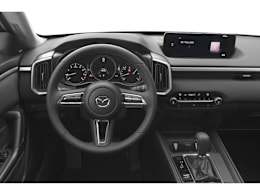Mazda might like active, outdoorsy buyers to think of the CX-50 as an alternative to the Ford Bronco Sport or Subaru Outback. We say ignore the marketing hype about off-road excursions, and instead focus on the CX-50’s sporty on-road handling, upscale cabin, and comfortable seats, because it’s in those areas that it excels when viewed against other small SUVs. Unfortunately, acceleration is on the slow side for the class with the base engine, the transmission suffers from some bumpy shifts, and the infotainment system is frustrating to use.
Based on the platform of the CX-30, the CX-50 slots between Mazda’s CX-5 and CX-70 SUVs sizewise. The CX-50, which comes standard with all-wheel drive, is longer and wider than the CX-5, and has both more ground clearance and a lower roof height. The latter allows adventure-focused buyers to more easily install and access roof racks and baskets.
The CX-50 truly shines on twisty stretches of two-lane blacktop, taking on corners in a way that's reminiscent of a Porsche Macan or a Jaguar F-Pace. Responsive, well-weighted steering and taut suspension give the Mazda a sense of eagerness. Ride quality suffers, though, in part due to our tested model’s 20-inch wheels—lower trims come with more rational 17s. As such, large bumps can send big impacts into the cabin, though body motions stay steady and controlled.
Power is merely adequate from the standard 2.5-liter 187-horsepower four-cylinder engine. It’s paired to a six-speed automatic transmission, at a time when most transmissions have at least eight speeds. Although the transmission responds quickly with a downshift when needed, both the up- and downshifts can be a bit rough. It posted a 0 to 60 mph time of 9.3 seconds, which is on the slow side for the small SUV class. Its fuel economy isn’t impressive, either, only managing 24 mpg overall on regular fuel.
A 227-hp turbocharged four-cylinder engine, also mated to a six-speed automatic, is available. It’s a more satisfying powerplant, thanks to heartier levels of low-to-midrange grunt. A hybrid powertrain is new for 2025.
Our tested Premium Plus model has an understated upscale look inside the cabin, with lots of padded surfaces and precise-feeling knobs and buttons. The front seats have comfortable cushions and ample side bolsters that hold you in place through turns. The driving position is mostly roomy, other than the plastic center console which hems in right-knee space. The rear seat has plenty of room, too, and the cargo area is significantly more generous than in the CX-5, thanks to a longer wheelbase and greater overall length.
But the infotainment system is frustrating and distracting to use while driving, as with other Mazdas. Even simple radio tasks require multiple taps and twists of the rotary controller knob. You can only use the touchscreen in conjunction with Android Auto and Apple CarPlay, but the screen is too far away from the driver to be useful.
Forward collision warning, automatic emergency braking with pedestrian and cyclist detection, blind spot warning, rear cross traffic warning, lane departure warning, lane keeping assistance, adaptive cruise control, and automatic high beams all come standard.


























